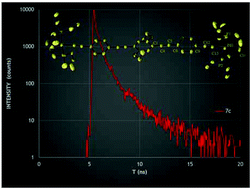Synthesis, characterization and solid-state photoluminescence studies of six alkoxy phenylene ethynylene dinuclear palladium(ii) rods†
Abstract
A rare family of six discrete binuclear [PdCl(PEt3)2] phenylene ethynylene rods with alkoxy side chains (methoxy, ethoxy and heptoxy) have been developed, and their solid-state photoluminescence results have been presented and discussed. The shorter bridging ligands are of the general formula H–C![[triple bond, length as m-dash]](https://www.rsc.org/images/entities/char_e002.gif) C–C6H2(R)2–C
C–C6H2(R)2–C![[triple bond, length as m-dash]](https://www.rsc.org/images/entities/char_e002.gif) C–H, where R = H, OCH3, OC2H5, and OC7H15, whereas the longer ones are based on H–C
C–H, where R = H, OCH3, OC2H5, and OC7H15, whereas the longer ones are based on H–C![[triple bond, length as m-dash]](https://www.rsc.org/images/entities/char_e002.gif) C–C6H4–C
C–C6H4–C![[triple bond, length as m-dash]](https://www.rsc.org/images/entities/char_e002.gif) C–C6H2(R)2–C
C–C6H2(R)2–C![[triple bond, length as m-dash]](https://www.rsc.org/images/entities/char_e002.gif) C–C6H4–C
C–C6H4–C![[triple bond, length as m-dash]](https://www.rsc.org/images/entities/char_e002.gif) C–H, where R = OCH3, OC2H5. These ligands display increasing length in both the main dimension (backbone length) as well as the number of carbons in the side chains (R, alkoxide side chain) that stem from the central phenylene moiety. The X-ray crystal structures of two of the prepared complexes are reported: one corresponds to a shorter rod, 1,4-bis[trans-(PEt3)2ClPd-C
C–H, where R = OCH3, OC2H5. These ligands display increasing length in both the main dimension (backbone length) as well as the number of carbons in the side chains (R, alkoxide side chain) that stem from the central phenylene moiety. The X-ray crystal structures of two of the prepared complexes are reported: one corresponds to a shorter rod, 1,4-bis[trans-(PEt3)2ClPd-C![[triple bond, length as m-dash]](https://www.rsc.org/images/entities/char_e002.gif) C]-2,5-diethoxybenzene (6c), while the second one is associated with a longer rod, the binuclear complex 1,4-bis[trans-(PEt3)2ClPd-4-(–C
C]-2,5-diethoxybenzene (6c), while the second one is associated with a longer rod, the binuclear complex 1,4-bis[trans-(PEt3)2ClPd-4-(–C![[triple bond, length as m-dash]](https://www.rsc.org/images/entities/char_e002.gif) C–C6H4–C
C–C6H4–C![[triple bond, length as m-dash]](https://www.rsc.org/images/entities/char_e002.gif) C)]-2,5-diethoxybenzene (7c). All new compounds were characterized by NMR spectroscopy (1H, 13C{1H} and 31P{1H}) as well as ESI-MS(TOF), EA, FTIR, UV-Vis, cyclic voltammetry and solid-state photoluminescence. Our work shows the influence of the alkoxy side chains on the electronic structure of the family of binuclear Pd rods by lowering its oxidation potential. In addition to this, the increase of the length of the bridge results in a higher oxidation potential. Solid state photoluminescence results indicate that Pd complexes are characterized by a marked decrease in both the emission intensity and the fluorescence lifetime values as compared to their ligands. This behaviour could be due to some degree of ligand-to-metal charge transfer.
C)]-2,5-diethoxybenzene (7c). All new compounds were characterized by NMR spectroscopy (1H, 13C{1H} and 31P{1H}) as well as ESI-MS(TOF), EA, FTIR, UV-Vis, cyclic voltammetry and solid-state photoluminescence. Our work shows the influence of the alkoxy side chains on the electronic structure of the family of binuclear Pd rods by lowering its oxidation potential. In addition to this, the increase of the length of the bridge results in a higher oxidation potential. Solid state photoluminescence results indicate that Pd complexes are characterized by a marked decrease in both the emission intensity and the fluorescence lifetime values as compared to their ligands. This behaviour could be due to some degree of ligand-to-metal charge transfer.



 Please wait while we load your content...
Please wait while we load your content...